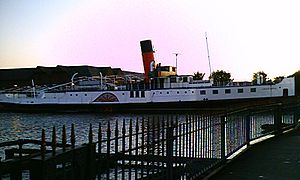PS Lincoln Castle
 The PS Lincoln Castle in Alexandra Dock, Grimsby. | |
| Career (UK) | |
|---|---|
| Name: | PS Lincoln Castle |
| Namesake: | Lincoln Castle, Lincoln, UK. |
| Owner: |
LNER (1934-1974) |
| Route: |
Humber Estuary crossing (1934-1974) |
| Ordered: | 1934 |
| Builder: | William Gray & Company, Hartlepool, UK, completed by A. & J. Inglis of Pointhouse, Glasgow. |
| Launched: | 24 September 1934 |
| Completed: | 1940 |
| Status: | Restaurant and bar moored on the Humber Estuary |
| General characteristics | |
| Type: | Paddlesteamer |
| Tonnage: | 556 GT |
| Length: | 209 feet (64 m) |
| Beam: | 56 feet (17 m) (including paddle box) |
| Propulsion: | Triple expansion, diagonal stroke, reciprocating steam engine |
| Speed: | 12.0 knots (22.2 km/h; 13.8 mph) |
PS Lincoln Castle was a coal-fired side-wheel paddle steamer, which plied across the Humber from the Second World War until 1978. She was the last coal-fired paddle steamer in regular services, in the UK. Later, she served as a pub at Hessle, and then a restaurant under permanent dock in Grimsby. Unless a buyer is found, the ship will be demolished in 2010.
History
PS Lincoln Castle was launched on 24 September 1934 by William Gray of Hartlepool and completed in 1940 by A. & J. Inglis of Pointhouse, Glasgow. She is named after the Norman castle at Lincoln.
She arrived on the Humber in 1941 to complement the existing similar ferries, the Wingfield Castle and Tattershall Castle. Initially used on routes around the estuary, as needed by the war effort, she was moved to the New Holland-Hull public service. The route was operated by the London and North Eastern Railway until nationalization in 1948, when it was taken over by British Railways, later known as British Rail. Lincoln Castle served this route until 1978, when she was unable to pass a boiler inspection. At the time of her withdrawal, she is understood to have been the last coal-fired paddle steamer providing regular services, in the United Kingdom.[citation needed]
The paddle steamer was converted into a pub and opened at Hessle, close to the Humber Bridge which had, since 1981, rendered the remaining ferries obsolete. In 1987, she was re-sold and moved to Immingham for refurbishment. She opened as a bar and restaurant in 1989 at the National Fishing Heritage Centre in Alexandra Dock, Grimsby, close to the retired fishing trawler Ross Tiger. In 2006, she was taken out of public use temporarily while renovations were conducted (ongoing as of 23 March 2007).
In 2010 it was announced that unless a new owner could be found, the vessel could be scrapped, despite the fact that she is a unique vessel and has survived these 70 years in remarkable condition. The Paddle Steamer Preservation Society were criticised for declining to take it over, preferring to concentrate on their existing ships,[citation needed] even though one - the MV Balmoral - is not a paddle-steamer. By 1st July 2010 demolition had commenced,[1]
Design
PS Lincoln Castle was built as a refinement of previous Humber ferry sisters, the Tattershal Castle and Wingfield Castle. She had a straight stem and counter stern with the usual rather fine lines of such a vessel though the paddle boxes and bridge sponsons gave an impression of a greater beam. Her length was 63.7 metres (209 ft) and beam 10 metres (33 ft), excluding sponsons. She could carry up to twenty cars (on her well quarter deck) and 1,200 passengers. The ship has been quoted to have a gross tonnage (GT) of anywhere from 550 to 598 tons
All her working life, her boiler was coal-fired and its steam used to power a triple expansion diagonal reciprocating engine. The cylinders were respectively 0.4575, 0.7245, and 1.1693 metres (18, 28.5 and 46 inches) in diameter with a 1.2964 metre (51 inch) stroke. She was different from the other vessels in the Humber ferry service in having her boiler forward of her engine, therefore her funnel was further forward than the others; just before midships, abaft the bridge and half way between her two equally-sized masts.
Footnotes
- ↑ "Time is running out for Lincoln Castle steamer as dismantling of vessel begins". Grimsby Telegraph. 2 July 2010. http://www.thisisgrimsby.co.uk/news/Time-running-Lincoln-Castle-steamer/article-2370691-detail/article.html. Retrieved 2 July 2010.
